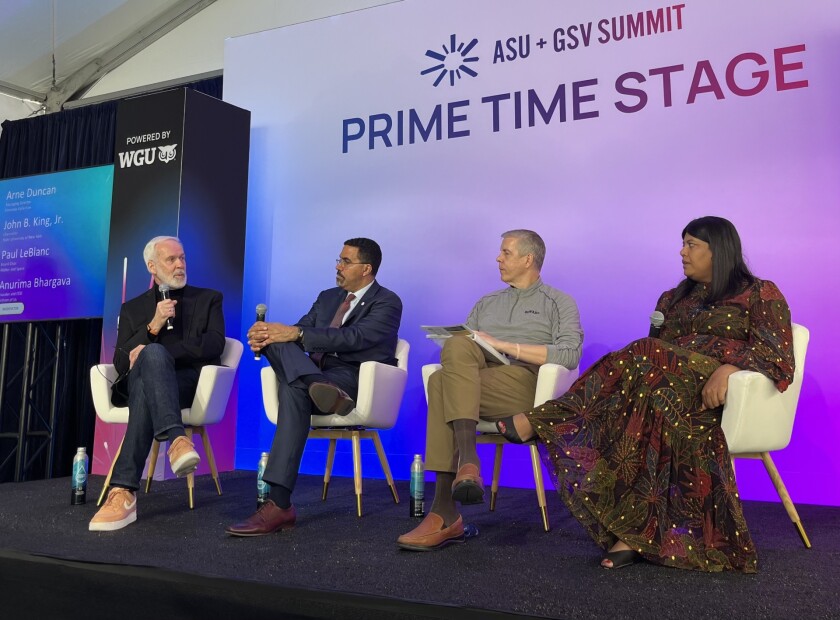In a panel discussion at the ASU+GSV Summit April 8 entitled “Nation vs. State: The Future of ‘Governing’ Education,” she said last year the federal government processed more than 17 million financial aid forms to provide billions of dollars in federal grants, including Pell Grants, and work-study funding to more than 9.9 million students at 5,400 colleges and career schools.
The panel included two past U.S. secretaries of education who served under former President Barack Obama, following a conversation with current Education Secretary Linda McMahon earlier the same day.
In the morning discussion, McMahon said cutting staff would not make programs like Title I funding and the Institute of Education Sciences (IES) go away but would shake things up to better serve learners. The afternoon panel outlined how cuts will do the opposite.
“There are half as many people in the department today as on Jan. 20. Now I know that the secretary acted this morning as though that has no impact, but that's just not true,” John King Jr., former secretary and current chancellor of the State University of New York (SUNY), said. “The reality is, those people had important jobs to make important systems work effectively for the country.”
As for specific impacts, in the short term, King pointed to more discrimination and worse financial services. In the long term, he said, a lack of thought leadership and a distracting conversation about ED will lead to a lack of ideas about education issues that really matter.

Abby Sourwine
DISCRIMINATION
Dismantling federal accountability checks on state and local education agencies will lead to more discrimination, King said. There are famous examples of this, like when Ruby Bridges walked to a previously all-white elementary school in Louisiana in 1960 and had to be escorted by federal marshals.
But there are many, less famous examples each year. The Office for Civil Rights wing of ED processed more than 22,000 complaints last year, Bhargava pointed out, breaking the previous year’s record.
ED's oversight was necessary because not every state or locality is a good actor all the time, according to Arne Duncan, King’s predecessor as secretary of education. For example, just a few years ago, $77 million in welfare funding in Mississippi flowed through the nonprofit Mississippi Community Education Center only to support a new volleyball facility at Brett Favre’s alma mater, Duncan said.
Taking away staff to resolve these complaints will lead to inequitable education, especially for students who experience discrimination on the basis of sex, disability, race, color or national origin under Title IX, as these make up the majority of the complaints, panelists said.
“If you’re a parent with a child with disabilities who’s not getting the services they’re entitled; if you’re a community-based organization that sees that in your district, systematically, students of color are not getting access to advanced placement classes; or you see other types of systematic discrimination; there's not going to be anybody to do anything about it,” King said.
FINANCIAL AID
Lack of staffing will also impact federal financial aid programs. If grant and loan payments are delayed, students who rely on grants and loans may not be able to attend school, panelists said. At SUNY, King said, nearly half of students receive Pell Grants, as do about a third of students nationally.
“If students don’t get their Pell Grants and student loans, we don’t have students,” King said. “That's bad for them. That’s bad for higher ed, but more importantly, it’s bad for our economy and it’s bad for our national security.”
Duncan pointed out that last year’s attempts to revamp the Free Application for Federal Student Aid (FAFSA) were “a disaster” that led to a decline in applications.
However, Paul LeBlanc, former president of Southern New Hampshire University and former volunteer for ED, said recent steps will not improve things. There already weren’t enough staff to go around, he said. One complaint about the FAFSA process is how many calls for assistance go unanswered: 74 percent of them last year, according to the U.S. Government Accountability Office.
“I have no faith in the ability to execute, because it is a wrecking-ball strategy. It is, ‘Let’s blow it up, let it fall apart, and then we’ll fix it later,'” he said. “In the meantime, they leave wreckage behind, and that wreckage is your kids. That wreckage is our college students.”
WHAT REALLY MATTERS
King worries that taking away staff and grants for research could have long-term impacts on discourse around important ideas in education. LeBlanc said this is also a concern on a global scale. Colleagues who used to look to the U.S. as a thought leader and see the American education landscape as a place to ask bigger questions and dream bigger dreams may now look elsewhere, namely China.
Duncan said this isn’t because of a lack of good ideas, but because it will now be more difficult to share them.
“For every educational problem, it is being solved somewhere magnificently. What we don't do in education is scale,” he said. “The U.S. Department of Education, if it does its job well, can support equity, can fight for excellence, and can scale innovation in a way that no other entity can.”
Panelists see this moment as an opportunity to rethink what education looks like for students, and to connect on elements that are bipartisan, bearing in mind that the states most reliant upon federal education dollars — Mississippi, South Dakota, Arkansas, Montana and Alaska — also voted Republican in the 2024 presidential election.
“There’s an invitation to rethink what the Department of Education will look like for the future,” LeBlanc said.









